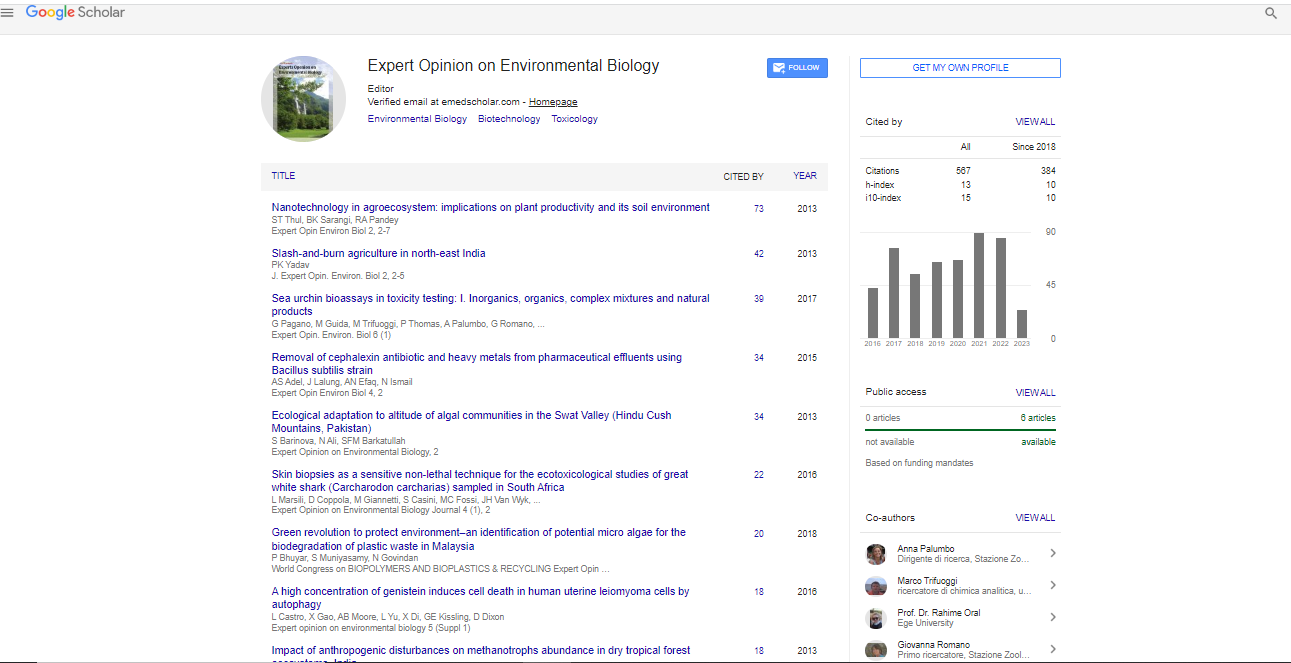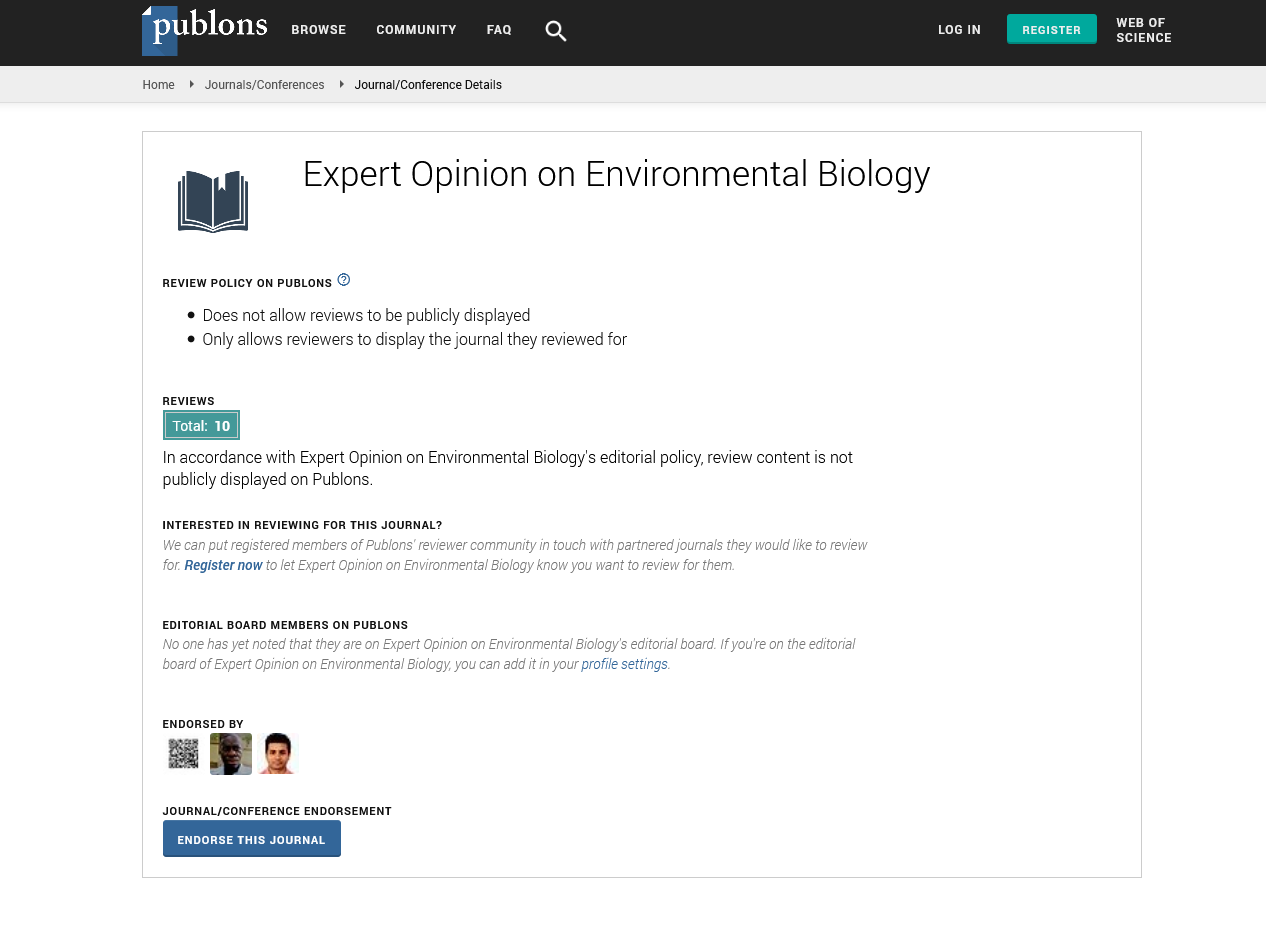Short Communication, Expert Opin Environ Biol Vol: 14 Issue: 1
Safeguarding Freshwater Ecosystems under Climate Change
Wuian Jing*
Department of Environment and Ecology, Tsinghua University, Shenzhen, China
- *Corresponding Author:
- Wuian Jing
Department of Environment and Ecology, Tsinghua University, Shenzhen, China
E-mail: wuianjing@tun11.cn
Received: 01-Mar-2025, Manuscript No. EOEB-25-169980, Editor assigned: 03-Mar-2025, PreQC No. EOEB-25-169980(PQ), Reviewed: 17-Mar-2025, QC No. EOEB-25-169980, Revised: 21-Mar-2025, Manuscript No. EOEB-25-169980(R), Published: 28-Mar-2025, DOI: 10.4172/ 2325-9655.1000241
Citation: Wuian J (2025) Advancing Cardiac Healing: The Role of Stem Cells in Regeneration and Future Prospects. J Regen Med 14:1.
Copyright: © 2025 Wuian J. This is an open-access article distributed under the terms of the Creative Commons Attribution License, which permits unrestricted use, distribution and reproduction in any medium, provided the original author and source are credited.
Abstract
Freshwater ecosystems, encompassing rivers, lakes, wetlands,
and groundwater systems, are among the most biologically diverse
and ecologically significant habitats on Earth. However, climate
change poses unprecedented threats to their integrity, altering
hydrological cycles, species distributions, and ecosystem services.
Rising temperatures, altered precipitation patterns, increased
evaporation, and extreme weather events are modifying water
quality, flow regimes, and biodiversity composition. These changes
threaten the provisioning of essential ecosystem services such as
drinking water supply, fisheries, recreation, and nutrient cycling.
Adaptation strategies, including habitat restoration, improved
water management, conservation policies, and community-based
stewardship, are crucial for enhancing resilience. This article
examines the major impacts of climate change on freshwater
ecosystems, identifies the most vulnerable species and habitats,
and explores effective adaptation measures to mitigate ecological
and socio-economic consequences.
Keywords: Climate change; Freshwater ecosystems; Biodiversity loss; Hydrological cycles; Ecosystem resilience; Adaptation strategies
Keywords
Climate change; Freshwater ecosystems; Biodiversity loss; Hydrological cycles; Ecosystem resilience; Adaptation strategies
Introduction
Freshwater ecosystems are integral to global biodiversity, human well-being, and climate regulation. Occupying less than 1% of Earth's surface, they harbor more than 10% of all described species, including a quarter of vertebrate diversity [1]. These habitats provide critical services, including potable water, food resources, carbon sequestration, flood regulation, and cultural benefits. However, climate changeâ??driven by anthropogenic greenhouse gas emissionsâ??is increasingly disrupting these systems, compounding the effects of pollution, habitat degradation, and overexploitation. Rising atmospheric temperatures are accelerating evaporation rates, altering rainfall distribution, and shifting seasonal flow patterns. Consequently, freshwater ecosystems are experiencing reduced water availability in some regions, more intense flooding in others, and increased susceptibility to invasive species and diseases [2]. Understanding these dynamics is essential for developing effective conservation strategies in the Anthropocene.
Description
- Temperature increases and thermal stress
Warmer air temperatures directly influence water temperatures, affecting dissolved oxygen levels and metabolic rates in aquatic organisms. Cold-water species such as salmonids are particularly vulnerable, as their thermal tolerance thresholds are exceeded, leading to population declines [3]. Additionally, warmer waters facilitate harmful algal blooms (HABs), which produce toxins that impair aquatic life and human health.
- Altered hydrological regimes
Climate change modifies precipitation patterns, increasing the frequency and intensity of droughts and floods. Reduced snowpack in temperate and polar regions diminishes spring meltwater flows, affecting riverine ecosystems. Conversely, extreme rainfall events increase sediment and nutrient loads, disrupting spawning grounds and degrading water quality.
- Ice cover loss in polar and alpine lakes
Shorter ice cover duration affects thermal stratification, nutrient cycling, and primary productivity in lakes. In Arctic regions, permafrost thaw releases stored carbon and methane, further exacerbating climate warming and altering aquatic chemistry.
- Biodiversity and species distribution shifts
Species ranges are shifting poleward or to higher altitudes as they seek suitable thermal conditions. However, physical barriers and fragmented habitats limit migration potential, increasing extinction risk for many endemic freshwater species [4].
- Invasive species proliferation
Warmer and more variable climates favor non-native species, which often outcompete native biota. For example, invasive zebra mussels in North America disrupt food webs and outcompete native mollusks. Climate change amplifies these pressures by weakening native speciesâ?? resilience [5].
- Water quality degradation
Changes in hydrology and temperature exacerbate nutrient loading from agricultural runoff, triggering eutrophication. Higher water temperatures also promote microbial contamination, posing risks to human health through waterborne diseases.
Results
Global studies reveal that freshwater species are declining at rates faster than terrestrial or marine species, with climate change being a primary driver [5]. The Living Planet Index for freshwater biodiversity has declined by over 80% since 1970. Observations indicate that glacial-fed rivers in the Himalayas, Andes, and Alps are experiencing reduced flows, affecting downstream agriculture and drinking water supplies. In tropical wetlands, altered rainfall regimes are leading to prolonged dry seasons, reducing fish productivity and increasing fire risks in peatlands.
Discussion
The interaction between climate change and other anthropogenic stressorsâ??such as urbanization, dam construction, and pollutionâ??creates cumulative pressures on freshwater ecosystems. While adaptation strategies exist, their effectiveness often depends on strong governance, cross-sector collaboration, and adequate funding. Integrated Water Resource Management (IWRM) offers a holistic framework for balancing water use between human needs and ecosystem requirements. Nature-based solutions, such as restoring riparian vegetation, re-meandering rivers, and reconnecting floodplains, enhance ecological resilience while providing co-benefits like carbon sequestration. Technological innovations, including remote sensing and environmental DNA (eDNA) monitoring, improve early detection of biodiversity changes and invasive species. Community engagement and indigenous knowledge also play vital roles in sustaining freshwater ecosystems in the face of climate change.
Conclusion
Freshwater ecosystems are on the frontline of climate change impacts, with consequences that ripple through ecological, economic, and social systems. Protecting these habitats requires urgent and sustained action that combines policy reform, habitat restoration, technological innovation, and community stewardship. By adopting adaptive, ecosystem-based approaches, societies can enhance resilience, safeguard biodiversity, and maintain the critical services provided by freshwater ecosystems for future generations.
References
- Abrams R (1984) Genetic studies of the schizoaffective syndrome: a selective review. Schizophr Bull 10: 26-29.
- Bleuler E (1958) Dementia praecox or the group of schizophrenias, New York (International Universities Press) 1958.
- Aron AR (2007) The neural basis of inhibition in cognitive control. The neuroscientist 13: 214-228.
- Aron AR (2011) From reactive to proactive and selective control: developing a richer model for stopping inappropriate responses. Biol psychiatry 69: e55-e68.
- Badcock JC, Michie PT, Johnson L, Combrinck J (2002) Acts of control in schizophrenia: dissociating the components of inhibition. Psychol Med 32: 287-297.
 Spanish
Spanish  Chinese
Chinese  Russian
Russian  German
German  French
French  Japanese
Japanese  Portuguese
Portuguese  Hindi
Hindi 
